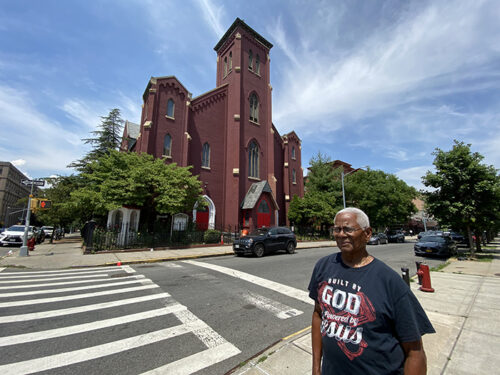
FORT GREENE — The familiar red-brick church, at the intersection of Willoughby Avenue and Kent Street, has had three name changes in its nearly 180-year history. In 1974, it received its last: St. Lucy-St. Patrick.
Since that time, Luis Delgado has been an active lay volunteer at St. Lucy-St. Patrick, located at 285 Willoughby Ave., working behind the scenes and out front as a greeter and overseer of collections.
These days, Delgado, 95, is the groundskeeper at the Fort Greene church, which has been shuttered since its last Mass in late Fall 2021 due to structural problems and a changing demographic.
Earlier this month, he gave a brief tour of the church where he and his late wife, Isabel, immersed themselves in parish life with their two sons. She died 19 years ago. Their sons are both retired now and in their 60s.
He showed where some of the bricks on the exterior had fallen. The holes were patched, but inspections revealed that more extensive repairs are needed. Estimated costs were in the millions, according to Father Henry Torres, pastor of Mary of Nazareth Parish and administrator of St. Lucy-St. Patrick. The diocese subsequently decided to close the church.
Bishop Robert Brennan on June 1 announced that the church “will no longer be used for divine worship.” This official decree became effective 30 days later on July 1. Following Canon Law, the decree was publicly posted on the diocesan website. It also orders that “any sacred furnishing and artwork” in the building be removed.
When the difficult decision to close a church is made, the detailed process is started to make sure items — such as the tabernacle, stained-glass windows, and statues, to name a few — are properly removed and preserved.
Mary of Nazareth Parish may retain items, but if it declines to take some pieces, the decree states they must be handled in a manner “befitting their character and the known intentions of any donor.”
Typically, such items are warehoused by the diocese’s Office of Patrimony in Bushwick, Brooklyn, where everything is photographed, documented, and appraised. Items can later become available to other parishes.
Canon Law states that former churches can be sold for secular purposes, but not for any activity considered immoral by the Church. However, the future use of the church has not been announced by the diocese.
According to the parish website, the original parish was formed in 1843. The church was then called St Mary’s, but 13 years later, it was renamed St. Patrick.

St. Lucy’s Church had been established in 1904 to serve the Italian residents of the area. In 1974, St. Lucy’s Church, located a few blocks north on Kent Avenue, was absorbed into St. Patrick, and the church was renamed St. Lucy-St. Patrick.
Many of the old-time Italian families have moved to other neighborhoods. In their place came an ever-growing community of Orthodox Jews, Father Torres said. Meanwhile, membership at St. Lucy-St. Patrick dwindled.
According to its website, Mary of Nazareth Parish, which included Sacred Heart and St. Michael-St. Edward, grew in 2011 with the addition of St. Lucy-St. Patrick.
On June 30, Father Torres said that he was researching the possibility of a special service to honor St. Lucy-St. Patrick. One of his first thoughts was to have a procession in which the Eucharist would be taken from St. Lucy-St. Patrick and brought to Mary of Nazareth Parish.
“I want to do something grand,” Father Torres said. “I want something very nice to kind of close it off.”
Delgado, meanwhile, will keep an eye on things.
“I live across the street,” he said, “so every time [Father Torres] needs me, he knows I’ll be around. Even now that it is closing, I still go around, pick up trash, and water the plants. We have a beautiful garden here.
“I love doing it because I’m very proud of my parish. Sometimes I cry because I really feel it, you know?”
He stops by most days to make sure everything is secure.
But sometimes, Delgado lingers inside the church for solitary prayer and reflection. During a visit on July 1, he sat in a front-row pew. His eyes were fixed on the altar and the sanctuary.
“I just sit here and look at my Lord,” he said to a visitor. “A lot of people don’t like to sit alone here because we had so many funerals here. But to me it is peaceful. I knew the departed. Most of them were friends — so many people that we knew.”
He motioned to a display of funeral cards from numerous services held at the church.
“Even my wife’s name is on there, someplace,” he said.
Delgado remembers when St. Lucy-St. Patrick was a thriving parish, with feast-day processions through the neighborhood, entertainment for all ages, and robust weekly collections. While the church holds many memories for Delgado, he did acknowledge and accept the reason for its closure.
“There is nothing we could really do about it,” he said. “The church needs a lot of repairs.”


It saddens me to read this. St. Lucy and St. Patrick’s are beautiful churches. The architecture of both is exquisite. I was baptized and married in St. Lucy’s as were my parents and relatives before me. Our family funeral masses were there. I attended St. Patrick’s School and received Eucharist and Confirmation there under the guidance of the Sisters of Mercy. Yes, demographics are changing and the Bishop has made the right decision because of the costly repairs.
God bless Mr. Delgado and Fr. Torres for their overseeing the property.
Maria Trapasso
San Diego, CA